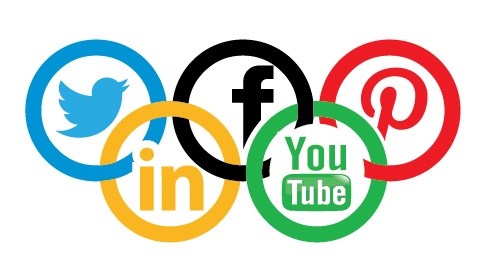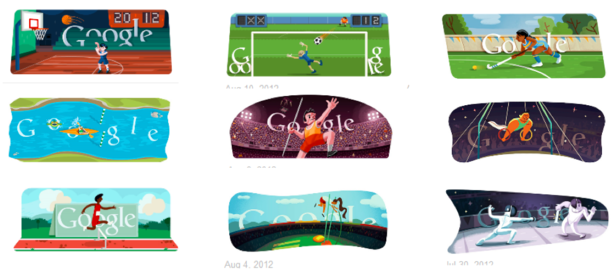With the 2016 Olympics in Rio looming, it is interesting to take some time to look back on how the London 2012 Olympics engaged audiences all over the globe through more digital channels than ever before. In their Marketing Report for London 2012, the International Olympic Committee reported that 2012 was the biggest Olympic Games in terms of the amount of broadcast coverage made available to fans around the world. It was also the first time that the total number of hours of digital output exceeded that of traditional television coverage. It is well known that digital coverage grew substantially since the Beijing Games with internet, mobile and other digital platforms becoming much more prominent throughout society.
Bosomworth (2012) reported how London 2012 Olympic Games-time traffic saw a staggering 109 million unique users across web and mobile, with 60% via search, meaning interestingly, most traffic came via Google. The Games’ link up with Google was also interesting as we saw 10 different Olympic themed Google doodles in 16 days, plus we saw how Google provided users with up to date results and medal leaderboards via search.
Stavros et al (2014) discussed how social media provides fans with an additional means to engage with their team and are a valuable forum for sport organizations to better understand fan motivations and strengthen fan relationships. Social media provide relationship-marketing opportunities for sport organizations and an additional avenue through which fans can engage with sport (Williams & Chinn, 2010). Encompassing a wide range of forums, social media presents a unique platform for marketers to create a dialog with consumers and for consumers to interact with each other. Because of this, it is also interesting to look at how more recently, digital marketing and social media impacted on the Sochi Winter Olympics in 2014.
The International Olympic Committee (IOC) tracked social media activity and reported that more than 2 million new fans joined the Olympic Facebook page during the Winter Games, the Olympic Twitter account amassed 168,101 new followers and the Olympic Instagram account gained more than 150,000 new followers. Naturally we can see the growing importance of these social channels for engaging with sporting audiences across the globe. Mark Adams, the IOC Director of Communications stated that for the IOC it is important to engage and connect with the home/hosting team, as once the Games have come to an end, the social legacy lives on as they want to keep connecting with our millions of new fans (Olympic.org), mirroring Heere & James’(2007) view that effective relationship marketing is critical in the sport environment.
I think it is clear to see that the use of digital media and marketing techniques are undoubtedly a major important part of engaging audiences with the Games. London 2012 was the most digitally enabled Olympic Games in history, with more people than ever tuning in to watch the events on more devices than ever before. I for one am really looking forward to seeing what the IOC and all the Games’ official partners will bring to the next Olympics in terms of content, advertising and viewer engagement and with the speed in which digital is evolving, i’m sure it won’t just be sporting world records that will be broken in 2016.
References
- Bosomworth, D. (2012) “Were the Olympics Games a digital marketing success?” Smartinsights.com [Online] Available at : http://www.smartinsights.com/digital-marketing-strategy/digital-strategy-development/were-the-olympics-games-a-digital-marketing-success/ Last Accessed 15/03/15
- Heere, B., & James, J. D. (2007). Sports teams and their communities: Examining the influence of external group identities on team identity. Journal of Sport Management, 21(3), 319–337.
- IOC Marketing Report London 2012. [Online] Available at http://www.olympic.org/Documents/IOC_
Marketing/London_2012/LR_IOC_MarketingReport_medium_res1.pdf Last Accessed 15/03/15 - Moth, D. (2012) “60 fascinating digital stats from the London 2012 Olympics” Econsultancy.com. [Online] Available at: https://econsultancy.com/blog/10871-60-fascinating-digital-stats-from-the-london-2012-olympics/ Last Accessed 15/03/15
- Olympic.org (2014) “Sochi 2014 social media metrics: Hot numbers. Cool conversations. All yours.” [Online] Available at: http://www.olympic.org/content/news/media-resources/manual-news/2014/02/28/sochi-2014-social-media-metrics-hot-numbers-cool-conversations-all-yours/ Last Accessed 15/03/15
- Stavros, C. Meng, M.D., Westberg, K., Farrelly, F. (2014) “Understanding Fan Motivation for Interacting on Social Media” Sport Management Review, Vol 17, Iss 4, Nov 2014, p455-469
- Williams, J., & Chinn, S. (2010). Meeting relationship–marketing goals through social media: A conceptual model for sport marketers. International Journal of Sport Communication, 3(4), 422–437.


Very impressive blog overall Catherine. This post on the Olympics is very interesting, especially with the European Football championship coming up in 2016 along with the Olympics. As you mentioned in other posts sporting organisations are really making the best use of social media now. It will be exciting to see who wins the battle regarding delivering the best content as well as the battle on the pitch!
LikeLiked by 1 person
Thanks Mark! Yeah totally, it will be really interesting to see does the European Football Championship roll out anything unique in terms of content! Definitely a lot of potential to engage audiences, your own post “Social Media Customer Engagement: How is it done?” is a great example of how they could do it! 🙂
LikeLike